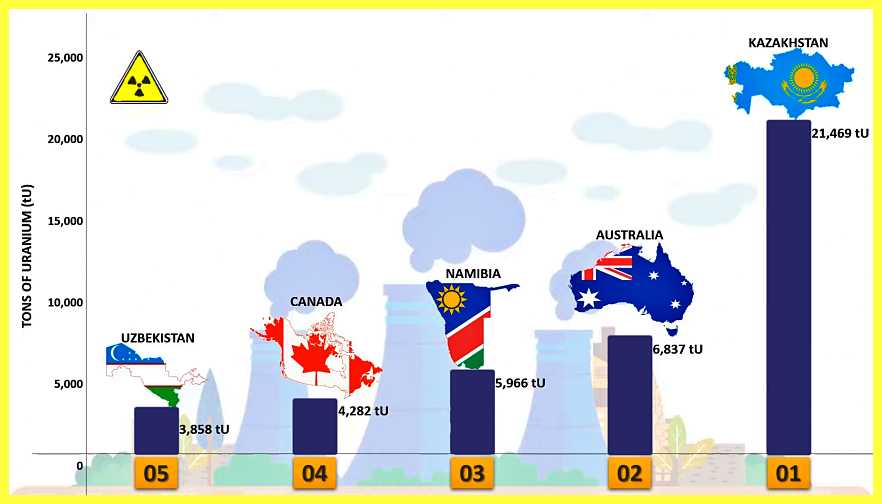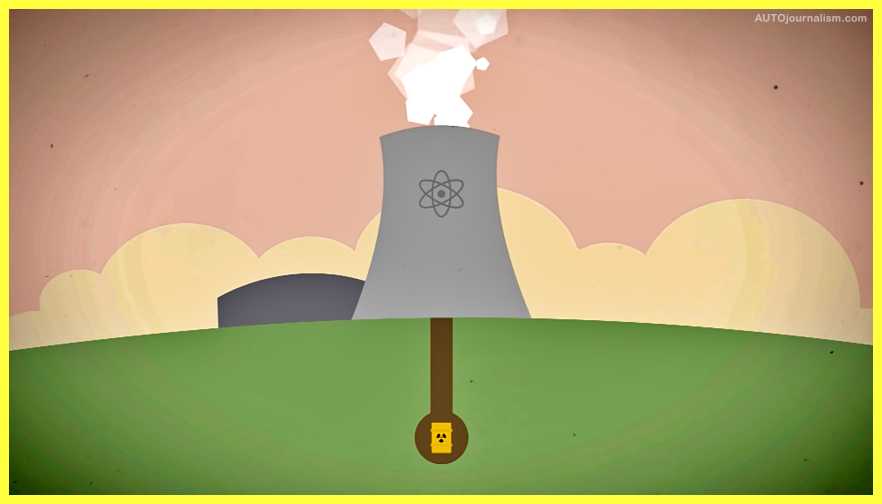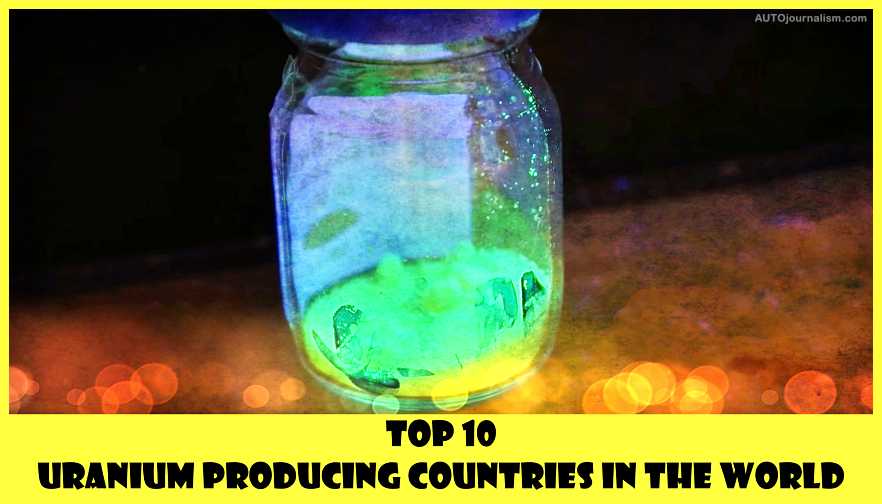Top 10 Uranium Producing Countries In The World
Here is the list of Top 10 Uranium Producing Countries In The World, Because of its density, uranium has been used as an abundant source of concentrated energy for more than 60 years. Uranium is found as tungsten or molybdenum in most rocks in the earth’s crust, and it costs around US 130 per kilogram. Nuclear submarines, aircraft carriers, and nuclear weapons all use uranium to generate electricity. Let’s have a look at the top ten countries with the most uranium production in recent years, keeping in mind that uranium output varies year to year.
List of Top 10 Uranium Producing Countries In The World

10. India (Uranium Producing country)
The total reserves of uranium in India are estimated at 30,480 tons it was estimated that 0.8 percent of the world’s total uranium production comes from India in 2020 India produced almost 441 u.s tons.
9. Ukraine (Uranium Producing country)
Ukraine is a natural resource-rich country that has large reserves of minerals like uranium and titanium as Europe’s top producer of uranium Ukraine ranks at number nine in the world with a total of about 820 us tons.
8. China (Uranium Producing country)
China now claims to be a uranium-rich country on the basis of some 2 million tons of uranium in 2020 uranium mine production in China amounted to an estimated 2077 us tons.
7. Russia (Uranium Producing country)
The world nuclear association states that Russia has known uranium deposits of 500 000 tons as of 2020 Russia produced 3136 tons of total uranium in the world.
6. Niger (Uranium Producing country)
Niger has two significant uranium mines providing about five percent of world mining output from Africa’s highest grade uranium ores the annual production of uranium in niger exceeds 2000 tons.
5. Uzbekistan (Uranium Producing country)
Uzbekistan has historically held uranium production information as confidential production of about 2400 tons of uranium had been estimated for 2017 2018 and 2019. however, in September 2020, Uzbekistan was producing approximately 3 500 metric tons or 3 858 u.s tons of fine uranium.

4. Canada (Uranium Producing country)
Canada is the world’s fourth largest producer of uranium with about 13 percent of total world production in 2020 Canada produced approximately 4 282 tons of uranium valued at over 500 million dollars.
3. Namibia (Uranium Producing country)
Uranium mining in Namibia is of considerable importance to the national economy in 2020 Namibia produced 11 of uranium worldwide ranked as the third largest producer in the world.
2. Australia (Uranium Producing country)
Australia’s known uranium resources are the world’s largest almost one-third of the world total it is the second largest uranium producer in 2020 about 6837 tons of uranium.
1. Kazakhstan (Uranium Producing country)
Kazakhstan has 12 percent of the world’s uranium resources and in 2020 produced about 21 000 us tons of uranium in 2009 it became the world’s leading Iranian producer with almost 28 percent of world production in 2020 Kazakhstan produced 41 of the world’s uranium.
Q-How do nuclear power plants work?
on a December afternoon in Chicago during the middle of World War two scientists cracked open the nucleus at the center of the uranium atom and turned to nuclear mass into energy over and over again they did this by creating for the first time a chain reaction inside a new engineering marvel the nuclear reactor since then the ability to mind great amounts of energy from uranium nuclei has led some to build nuclear power as a plentiful utopian source of electricity.

1 kilogram of fuel to power an average American household for nearly 34 years
a modern nuclear reactor generates enough electricity from one kilogram of fuel to power an average American household for nearly thirty-four years but rather than dominate the global electricity market nuclear power has declined from an all-time high of 18 percent in 1996 to 11 percent today and it’s expected to drop further in the coming decades what happened to the great promise of this technology it turns out nuclear power faces many hurdles including high construction costs and public opposition and behind these problems lie a series of unique engineering challenges nuclear power relies on the fission of uranium nuclei and a controlled chain reaction that reproduces this splitting in many more nuclei the atomic nucleus is densely packed with protons and neutrons found by a powerful nuclear force most uranium atoms have a total of 238 protons and neutrons but roughly one in every one hundred forty lakhs three neutrons and this lighter isotope is less tightly bound.
Uranium-235 Nuclei
compared to its more abundant cousin a strike by a neutron easily splits the u-235 nuclei into lighter radioactive elements called fission products in addition to two to three neutrons gamma rays and a few neutrinos during fission some nuclear mass transforms into energy a fraction of the newfound energy powers the fast-moving neutrons and if some of them strike uranium nuclei fission results in a second larger generation of neutrons if this second generation of neutrons strike more uranium nuclei more fission results in an even larger third generation and so on but inside a nuclear reactor this spiraling chain reaction is tamed using control rods made of elements that capture excess neutrons and keep their number in check with a controlled chain reaction a reactor draws power steadily and stable for years the neutron lead chain reaction is a potent process driving nuclear power but there’s a catch that can result in unique demands on the production of its fuel it turns out most of the neutrons emitted from fission have too much kinetic energy to be captured by uranium nuclei the fission rate is too low and the chain reaction fizzles out the first nuclear reactor built in Chicago used graphite as a moderator to scatter and slow down neutrons just enough to increase their capture by uranium and raise the rate of fission.
modern reactors commonly use purified water as a moderator but the scattered neutrons are still a little too fast to compensate and keep up the chain reaction the concentration of u-235 is enriched to four to seven times its natural abundance today enrichment is often done by passing a gaseous uranium compound through centrifuges to separate lighter u-235 from heavier u-238 but the same process can be continued too highly enriched u-235 up to 130 times its natural abundance and create an explosive chain reaction in a-bomb methods like centrifuge processing must be carefully regulated to limit the spread of bomb grade fuel.

Nuclear Power Fission Energy
remember only a fraction of the released fission energy goes into speeding up neutrons most of the nuclear power goes into the kinetic energy of the fission products those are captured inside the reactor as heat by a coolant usually purified water this heat is eventually used to drive an electric turbine generator by steam just outside the reactor water flow is critical not only to create electricity but also to guard against the most dreaded type of reactor accident the meltdown if water flow stops because a pipe carrying it breaks or the pumps that push it fail the uranium heats up very quickly and melts during a nuclear meltdown radioactive vapors escape into the reactor and if the reactor fails to hold them a steel and concrete containment building is the last line of defense but if the radioactive gas pressure is too high containment fails and the gases escape into the air spreading as far and wide as the wind blows the radioactive fission products in these vapours eventually decay into stable elements while some decay in a few seconds others take hundreds of thousands of years.
Nuclear Reactor
the greatest challenge for a nuclear reactor is to safely contain these products and keep them from harming humans or the environment containment doesn’t stop mattering once the fuel is used up in fact it becomes an even greater storage problem every one to two years some spent fuel is removed from reactors and stored in pools of water that cool the waste and block its radioactive emissions the irradiated fuel is a mix of uranium that failed to fission, fission products and plutonium a radioactive material not found in nature this mix must be isolated from the environment until it has all safely decayed.
Tunnels Drill
many countries propose deep time storage in tunnels drilled far underground but none have been built and there’s great uncertainty about their long-term security how can a nation that has existed for only a few hundred years plan to guard plutonium through its radioactive half-life of 24,000 years today many nuclear power plants sit on their waste instead of storing them indefinitely on-site apart from radioactivity there’s an even greater danger with spent fuel plutonium can sustain a chain reaction and can be mined from the waste to make bombs storing spent fuel is thus not only a safety risk for the environment but also a security risk for nations, who should be the watchman to guard it
visionary scientists from the early years of the nuclear age pioneered how to reliably tap the tremendous amount of energy inside an atom as an explosive bomb and as a controlled power source with incredible potential but their successors have learned humbling insights about the technologies not so utopian industrial limits mining the subatomic realm makes for complex expensive and risky engineering.
Read also:
Top Best Reconnaissance Aircraft



